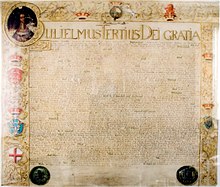Personal union between Great Britain and Hanover
The personal union between Great Britain and Hanover existed from 1714 to 1837. During this time, the Elector of Braunschweig-Lüneburg or King of Hanover was also King of Great Britain . With the Act of Settlement in 1701 , the English Parliament created the new basis for the Protestant succession to the throne in the Kingdom of England . Different rules of succession led to the dissolution of the personal union .
After the death of Queen Anne Stuart of Great Britain , who remained without descendants , the Elector of Braunschweig-Lüneburg, Georg Ludwig , inherited the British royal crown as the next Protestant relative in 1714 , in accordance with the Act of Settlement of 1701. Through this personal union, Georg Ludwig connected Great Britain with the German Electorate, which became one of the most powerful in the Holy Roman Empire. However, Hanover should keep its independence, which is why the state coffers and government business remained separate. Kurhannover was administered and governed by the German Chancellery in London and the Hanoverian minister there, as well as the secret council in Hanover, who conferred with the ruler and carried out his instructions. Only Georg Ludwig and his son Georg August traveled to the electorate. The personal union did not end until 1837 with Queen Victoria's accession to the throne , since in the Kingdom of Hanover, the successor state of the Electorate of Braunschweig-Lüneburg, only male descendants could inherit the throne. Hence the rule in Hanover passed to Victoria's uncle, Ernst August , Duke of Cumberland .

Succession to the throne of the personal union:
- George I (from August 1, 1714)
- George II. (From October 11, jul. / October 22, 1727 greg. )
- George III (from October 25, 1760)
- George IV (from January 29, 1820)
- Wilhelm IV. (From June 26, 1830)
Title of the line of succession in personal union:
- King of Great Britain (until 1801)
- Kingdom of Ireland (until 1801)
- King of the United Kingdom (from 1801)
- Elector of Braunschweig-Lüneburg (until 1806)
- King of Hanover (from 1814)
See also
- Exhibition When the Royals came from Hanover . Hanover's ruler on England's throne 1714-1837 as part of the Lower Saxony State Exhibition 2014
swell
- Richard Drögereit : Sources on the history of Kurhannovers in the age of personal union with England 1714-1803. Source booklets on Lower Saxony history, Hildesheim 1949.
literature
- Ronald G. Asch (Ed.): Hanover, Great Britain and Europe. Experience area personal union 1714–1837 (= publications of the Historical Commission for Lower Saxony and Bremen 277). Wallstein-Verlag, Göttingen 2014, ISBN 978-3-8353-1584-6 . [with contributions to the current research situation]
- Heide Barmeyer (Ed.): Hanover and the English succession to the throne (= Hanoverian writings on regional and local history, Volume 19). Bielefeld 2005.
- Torsten Riotte : Hanover in British Politics, 1792–1815. Dynastic connection as an element of foreign policy decision-making processes . Historia profana et ecclesiastica Vol. 13, Lit, Münster 2005, ISBN 3-8258-7551-2
- Torsten Riotte, B. Simms (Ed.): The Hanoverian Dimension in British History. Cambridge University Press, Cambridge 2007, ISBN 978-0-521-84222-8 . [important recent individual studies]
- Georg Schnath : History of Hanover in the age of the ninth cure and the English succession 1674–1714. 4 volumes. Lax, Hildesheim / Leipzig 1938–1982. [comprehensive description of the transition to the House of Hanover]
